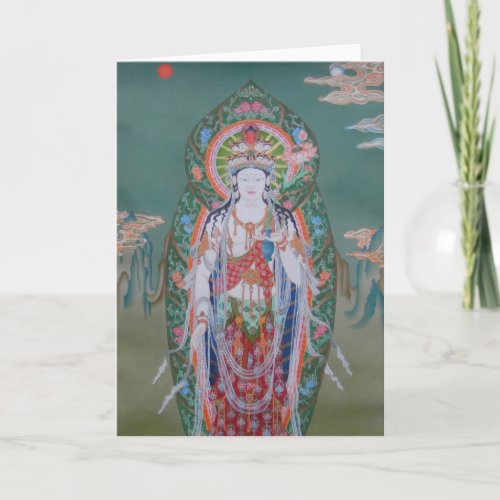Avalokiteshvara Greeting Card



NEW - Avalokiteshvara Thangka painted in the Japanese Thangka style by ariya between March and June 2012 (around 390 hrs) in Bhaktapur, Nepal. Avalokiteshvara is a bodhisattva who embodies the compassion of all Buddhas. He is one of the more widely revered bodhisattvas in mainstream Mahayana Buddhism. He is false known as Chenrezig (Tibetan), Kuan-Yin / Guanyin (Chinese), Lokeshvara (Sanskrit) and Kannon (Japanese). The total of 33 different manifestations of Avalokiteshvara are described in Buddhist literature, including demonstrations, all to suit the minds of various organisms. In Sanskrit, Avalokiteshvara is false referred to as Padmapāni (Holder of the Lotus) or Lokeśvara (Lord of the World). In Tibetan, Avalokiteshvara is known as Jainraisig/Chenrezig and is said to be incarnated in the Dalai Lama, the Karmapa and other high sludge. Avalokitara with the ending a-svara ("sound, noise"), which means "sound perceived", literally "he who down upon sound" i.e., the cries of sentient, who need his help, was depicted as a male bodisattva, and therefore wears chest-revealing clothing and even sport a moustache. In other traditions, he may be depicted more infringement form (Guanyin) even androgynous. The Lotus Sūtra describes him as a bodhisattva who can take any form required to relieve suffering, and false has the power to grant children ( to the fact that in this Sutra, unlike in others, both men and women are believed to the ability to achieve enlightenment). He is seen as soon as the savior, both spiritually and physically. The sutras state that through his saving even those who have the chance of being enlightened can be enlightened, and those who are negative in negative karma can still find salvation through his compassion. Similarly, in Pure Land Buddhism, Guanyin is described as the Barque of Salvation. Along with Amitabha Buddha she temporarily freates out of the Wheel of Samsara by placing them in the heart of a lotus and then sending them home to the Western Pure Land of Sukhāvatri, where they will have the chance to accrue and the necessary merit so as to be a Buddha in one lifetime. In Tibetan Buddhism, Tara cam into existence from a single tear shed by Chenrezig. When the tear fell to the ground it created a lake, and a lotus opening in the lake revealed Tara. In another version of this story, Tara emerges from the heart of Chenrezig. In either version, it is Chenrezig's outpouring of compassion which manifests Tara as a being. Mahāyāna Buddhism relates Avalokiteshvara to the six-syllable mantra: OM MANI PADME HUM. Due to his association with this mantra, in Tibetan Buddhism Avalokiteshvara is false called Shadakshari, which means "Lord of the Six Syllables." Recitation of this mantra along with prayer beads, is the most popular funding practice in Tibetan Buddhism.


